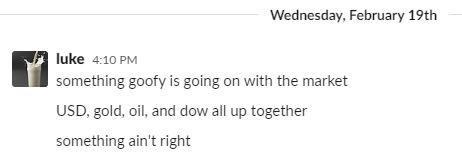Coronavirus Is NOT The Reason For Today's Sell-off
Every major media and financial outlet blamed today's market sell-off on spreading coronavirus fears. Too bad it's bullshit.
Let's take a look at some of today's headlines:
"Dow Industrials Close 1000 Points Lower as Coronavirus Cases Mount" - Wall Street Journal
"U.S. Stocks Plunge as Coronavirus Crisis Spreads" - The New York Times
"Coronavirus Is Cratering the Stock Market. Why It Can Still Get Worse" - Barron's
"U.S., Global Markets Plunge as Coronavirus Cases Spike Outside China" - Washington Post
"Dow Ends More Than 1,000 Points Lower as Coronavirus Spread Sparks Fear of Global Economic Hit" - MarketWatch
"Global Stock Markets Plunge on Coronavirus Fears" - BBC
"Global Stocks Have Worst Day in Two Years as Coronavirus Fears Spread" - Financial Times
"Stocks Fall as Coronavirus Fears Hit Global Markets" - The Guardian
"Dow Jones Futures Dive As Stock Market Rally Faces Possible Coronavirus Pandemic" - Investor's Business Daily
While nCov-19 certainly has the potential to disrupt markets globally, the spread of the virus over the weekend has little to nothing to do with today's big sell-off. And there's really good evidence for that. First some numbers...
Last Friday, health officials report 75,456 confirmed infection cases which had caused 2,236 deaths. Today's official reports say there are now 79,441 confirmed nCov-19 cases with 2,620 deaths.
So over the past three days, the number of confirmed cases has increased 5.3% with the number of deaths increasing by 17.2%, with the latter being the bigger cause for alarm. This increase is what's being blamed for today's sell-off.
But if an increase of 5.3% in the number of nCov cases and 17.2% in the number of deaths lead to a 1,000 point sell-off in the Dow, why has it been generally increasing since the beginning of the outbreak?
Since the first confirmed case on December 1, 2019, the Dow Jones increased 27.3% (not including today).

Even since the WHO declared the outbreak to be a Public Health Emergency of International Concern on January 30, 2020 - which was also the date of the first confirmed spread of nCov-19 between two people in the United States - the Dow increased slightly by 0.5% (not including today).
In that time the number of confirmed nCov-19 cases has increased over ten-fold with the number of deaths increasing 1215.3% through last Friday.
If a ten-fold increase in cases and a +1,200% increase in deaths didn't cause stocks to plummet, why did a 5.3% increase in the number of cases and a 17.2% increase in the number of deaths cause a 1,000 point drop in the Dow?
Answer: It didn't
Besides, if the recent increase was the primary reason for today's sell-off, Dow futures wouldn't be trending higher right now.

The fact is commodity and futures prices were signaling serious market concerns as early as last Tuesday. The USD, gold, and stocks were all flying high last week. Meanwhile, index futures went into backwardation.
In fact, let me share with you some private Slack messages I sent to fellow employees last Wednesday.


So what caused all this?
Well, a number of things. But mostly the simple fact is stock markets are overbought and over-hyped.
Over the past few years, since Donald Trump took office in fact, the stock market has been to a historic tear higher. And as much as he and the Wall Street guys want you to believe, that can't last forever.
A market correction was inevitable with or without coronavirus.
So why has every major media and financial outlet blamed today's market sell-off on spreading coronavirus fears?
Well, I can only speculate on that. But my best guess is they know coronavirus will most likely just turn out to be another flash in the pan virus - like the Swine Flu or the Bird Flu - and once the rest of the world figures that out they can try to convince you to keep pumping the market up more and more.
Don't buy into it folks. Hype is real. And it creates bubbles, which eventually bust.
Until next time, Luke Burgess
Luke Burgess
As an editor at Energy and Capital, Luke's analysis and market research reach hundreds of thousands of investors every day. Luke is also a contributing editor of Angel Publishing's Bull and Bust Report newsletter. There, he helps investors in leveraging the future supply-demand imbalance that he believes could be key to a cyclical upswing in the hard asset markets. For more on Luke, go to his editor's page.